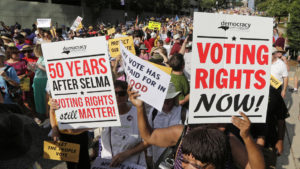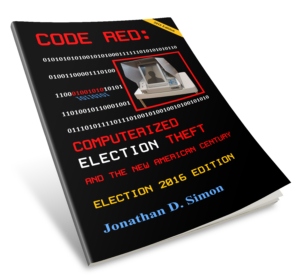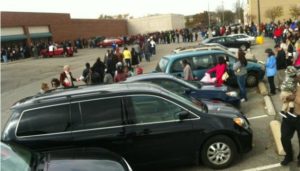Donald Trump was right. In a twisted way.
Trump claimed that the presidential election was “rigged” against him. His advance declaration that he wouldn’t vow to accept the results of the election was met with loud efforts to reassure the public that our elections are safe, and rigging is not possible.
That’s where the politicians and the media had it wrong.
Politicians and the media want you to trust our election system and Americans do deserve that. But the solution is to make our election system trustworthy, not just to claim that it is. The truth about our vote-counting process is that it is computerized, privatized, outsourced to a few corporations and, above all, unobservable. Which means that it is vulnerable to systemic fraud and it cannot prove or demonstrate that it is fraud-free.
Our elections are not safe. Rigging is possible. Computerized vote counting, taking place in the pitch-dark of cyberspace, is open to manipulation and election theft by outsiders, including foreign state actors like Russia, and even more open to insiders with easy access.
In thinking about our elections to come and how our votes are counted, there are some myths and facts we all should consider. As you read through the Myths and Facts below, judge for yourself how secure and worthy of trust our current election system is and how critical it is that we collectively take the necessary steps to fix it.
Myth 1:
If we trust ATMs with our money, we can trust computers to count our votes
Fact:
These two uses of computers are radically different. If an ATM “made a mistake” or was programmed to take your deposited check and add it to the account of someone else, you’d notice the missing check on your next bank statement. You’d go down to the bank and ask politely (or not) what had become of it. You’d know there was a problem, and so would everyone else who was being scammed. This deters banks and their employees from trying to steal your money.
Any “broken” ATM would quickly be discovered and fixed.
With voting, however, if the touchscreen or scanner or central tabulator “made a mistake” or was programmed to delete your vote or flip it to a different candidate invisibly, you would have no idea that this had happened. Thousands, ultimately millions, of votes could be affected without knowledge of voters or election officials. Voting on computers, unlike using an ATM, is 100% “faith-based.” We have just come to assume that because America is a great democracy, computerized election theft could never happen here.
Myth 2:
My vote didn’t “flip” on the screen, so everything’s OK
Fact:
It is child’s play to program a touchscreen computer to display a vote for “A” on the screen and record a vote for “B” on its memory card. Same with the new barcode ballot-marking devices (BMDs), which are currently being rushed into deployment in many key states: the human-unreadable barcode or QR code is the vote of record and can easily be programmed to differ from the readable choices printed on a “summary card.” As for counting, it takes three inserted lines of code (out of 500,000 or so lines of code already on a memory card) to offset the “zero counters” to start the count for “A” at, say, +100 and for “B” at -100. At the close of voting the machine shows the “correct” number of total votes (+100 – 100 = 0) and the election administrator sees and certifies a clean election, even though a net of 200 votes were shifted. This and many other games are what make vote counting on computers so vulnerable and so dangerous.
Myth 3:
As long as I hand-mark a paper ballot, my vote is safe
Fact:
98% of paper ballots, whether cast at your precinct or mailed in, are counted by computers known as optical scanners (“opscans”). Inside is a memory card, smaller than a credit card, programmed with over 500,000 lines of code. Opscans read ballots and count votes according to the way they were programmed by the corporation that produced them or whoever hacks into them. They even break some votes down into little pieces, hundredths of a vote. As noted in Myth 2 above, sneaking three lines of code into the 500,000+ lines on the memory card can completely change the election results. Such rigs are easy and could be done by a high school-level coder.
Myth 4:
Election audits protect our vote by catching any errors
Fact:
There is no uniform audit of American elections. Many states, including some of the key swing states in this year’s election, have no audits at all. Others have audits that are ineffective owing to one or more of these factors:
- the sample is way too small
- the places to be audited are tipped off in advance
- with BMDs, what’s being audited are the computer’s choices, not necessarily the voter’s
- the audit is conducted in private, days after the election
- the chain of custody of the ballots has not been maintained
Unless audits are made uniform, performed truly at random on Election Night before the ballots are moved, and given real teeth, they offer nothing but a false sense of security.
Myth 5:
The fact that each state runs its own elections and uses different equipment makes major election theft impossible
Fact:
There are actually very few voting equipment vendors and very few types of equipment. Virtually all of it is vulnerable to rigging and virtually all of it is under the technical control of the manufacturers and their sub-contractors. State and local election administrators rarely have the technical capacity (the “chops”) to “look under the hood” and know what the contractors are doing or how the programming works. The public is told to take on faith that everyone with access to the computers, their programming, maintenance, and distribution, is serving the public interest rather than a private or partisan agenda. Given the ethics of politics and of our time, that is asking a lot.

Myth 6:
Polls are just predictions and have nothing to do with protecting our elections from fraud
Fact:
A specific kind of polling—exit polling—is the main way that countries around the world are alerted to the presence of fraud in their elections. Before vote counting was handed over to the computers, exit polls in America were consistently accurate. They are still accurate in countries like Germany that use hand counting. In the 2016 presidential primaries, the exit polls got nearly all the Republican primaries right and all the Democratic primaries wrong (nearly all in the same direction!), using the same methods, at the same precincts, on the same days. Then, in the general election in November 2016, while the National Exit Poll was accurate to 1.1%, the red shifts (disparity between exit poll and votecount) in the key states that Trump swept by tiny margins for his Electoral College victory were well outside the margins of error and outcome-reversing: 2.5% in Florida, 4.6% in Wisconsin, 5.1% in Pennsylvania, and 5.6% in North Carolina! A single exit poll isn’t perfect, but when we keep seeing egregious telltale patterns like that, it’s time to look at the votecounts and see what might be “off” with them. Put another way, on what basis should we have more faith in secret computerized votecounts than we do in far more transparent exit polls?
Myth 7:
The biggest danger to our elections comes from outside hackers like the Russians
Fact:
There’s a lot of worry of late that some foreign country might take advantage of the security holes in our voting system to mess with our elections. That’s certainly not impossible but … it is even easier for the insiders programming and distributing the computers to shift votes and change results. While outside hackers have relatively limited access to the vote counting process (only where it goes through the internet), insiders working anywhere within the secretive outfits that count our votes have total access to the whole vote counting system. So it’s as if, worried about the security of our “electoral house,” we’re going around checking windows for signs of forcible entry–all the while completely ignoring the folks with keys to the front door, who are sitting around the kitchen table drinking a beer! With so much at stake in our elections, the Russians are obviously not the only ones with a motive (and cash) to dictate outcomes. Yet the mainstream media absolutely refuses to say a word about the domestic danger. Why?
Myth 8:
Voting machines are tested to make sure they’re counting accurately
Fact:
Where voting machines are tested, it is often by the vendors themselves or by outfits paid by the vendors, an obvious conflict of interest. Even when the testing is done by well-meaning election officials, it is not difficult to program a computer to pass a pre-election test (and a post-election test) with flying colors but tabulate the votes inaccurately when it counts on Election Day. The automobile manufacturer Volkswagen was caught doing exactly this with their cars—programming them to pass emissions tests and then pollute up a storm once they were sold and on the road for real. Election rigging is cybercrime. Like other types of cybercrime, it’s easy to do and difficult to prevent or detect.
Myth 9:
Ballots are always public records and, if there is any question, candidates or voters have a right to examine them
Fact:
State after state has been passing legislation to remove ballots from the reach of public records laws like the Freedom of Information Act. Again and again, investigators have been denied access to voter-marked ballots and to memory cards and computer code used to count them. The whole process is becoming less, not more, transparent. Even in the most suspect elections, citizens almost never have the right to an observable count of the ballots. Where candidates might technically have such a right, it is made too expensive for candidates–their war chests depleted at the end of their campaigns–to afford. The ballots, like the memory cards that do the counting, are regarded as strictly corporate property. All that investigators of suspect elections can do is try to bring attention to the recurring data patterns that don’t fit with honest and accurate vote counts. That evidence is almost always ignored or discounted by government and media alike.
Myth 10:
Election thieves are so focused on the White House that they don’t pay much attention to other contests
Fact:
There is pervasive evidence of electoral cyber-theft all the way down the ballot. With down-ballot contests like the U.S. House of Representatives and state legislatures, the risk of detection is super low (no exit polls, very little attention and scrutiny) but the reward is huge: long-term control of American politics. State legislatures can pass restrictive Voter ID laws, gut any campaign finance regulations that have been left in place by the Supreme Court, and lock in permanent majorities through gerrymandering. This is exactly what has happened. The media focuses 99% of its attention (and the public’s attention) on the presidency, but election thieves are smarter than that.
Myth 11:
Obama’s victory in 2012 proves that US elections are secure
Fact:
When Ohio’s official state vote counting computers “went down” late on Election Night (at just about the same time as they “went down” in 2004, sending the votes to backup servers set up by Karl Rove’s late “IT guru,” Mike Connell), Rove was on FOX News publicly disputing his own network’s call of Ohio and the presidency for Obama. He ominously referred to “server problems” and predicted a late-night turn-around in the results. But the organization Anonymous revealed that it had infiltrated Rove’s “ORCA” operation and changed the passwords, locking Rove’s techies out of the computers set up to do what many forensics specialists believe Connell’s had done in 2004—flip the votes. “May the best cyber-thief win” is not what you probably think of as a “secure election.”
https://www.youtube.com/watch?v=zANRaBoscpg
Myth 12:
The Voting Rights Act protects people of color from discrimination in elections
Fact:
In a 5-to-4 party-line decision the Supreme Court recently gutted the key provision of the Voting Rights Act that protected minorities from Jim Crow discrimination and cynical voter suppression laws and regulations. Making it harder to cast a vote has become a big part of winning elections (or at least narrowing the gap to the point where vote-shifting computers can reverse the result while passing the smell test). One trick played in many red and swing states is to close local precincts and combine a whole bunch of them into “voting centers.”
That’s fine, as long as you have a car to get to voting places miles away and lots of leisure time to wait for hours to vote. This is not random or geographical or budgetary—it is a deliberate tactic that effectively suppresses the vote of the poor, the young, the elderly, and minorities. The less effectively you govern and the less popular you become, the more thumbs it takes on the electoral scales to keep your hold on power. Both STRIP (targeted voter suppression) and FLIP (targeted votecount manipulation) become necessary elements of the game plan.
Myth 13:
Election theft is obviously taken more seriously than the air pressure in footballs
Fact:
Millions of dollars were spent investigating “Deflategate.” Footballs and cellphones were impounded, possible perps and witnesses grilled. The science of air pressure, the character of everyone from Tom Brady and Roger Goodell to Ted Olsen, every forensic finding and legal maneuver, were national headline news for months. Memory cards and code used to program voting computers are never impounded, never examined—no matter how suspect an election’s result. Neither are the actual voter-marked ballots. Is this because in America football matters more than the results of our elections and the direction of our country?
Myth 14:
Election rigging and hacking may be possible, but those things haven’t happened yet.
Fact:
With cheating everywhere from athletics to academics to Wall Street, do you really believe that super high-stakes and super vulnerable American elections would be immune? A great deal of forensic evidence indicates that election theft has happened throughout the computerized vote counting era. Because all “hard” evidence—like memory cards, code, and voter-marked ballots—is strictly off-limits to public inspection, almost all of the tell-tale evidence involves numbers and comparisons, and consistently bizarre patterns. The complex nature of the evidence makes it possible for those who don’t want to check the air pressure in our electoral footballs to dismiss it or ignore it.
Myth 15:
Hand counting ballots only works in small towns, there are just too many voters in big towns and cities
Fact:
Where there are more voters and more ballots, there are more counters to count them. It’s proportional. Humans counted votes in America for the better part of two centuries. It would take four hours once in each voter’s life to restore an observable vote counting process with hand-counted ballots. We’ve spent $2 billion a week on our mission to bring “democracy” to Iraq and Afghanistan. A month of Iraq/Afghanistan would buy us 30 years of hand-counted elections at a pay rate of $20/hour here in America. And it would actually cost less than continuing to use the computers.
https://www.youtube.com/watch?v=LY1cHtcwzy4
Myth 16:
“Voter fraud” is a huge problem in U.S. elections
Fact:
Voter fraud is extremely rare and has virtually zero impact on election outcomes. Proponents of Voter ID laws tried mightily to support their legislation with examples of the voter fraud it was supposedly intended to prevent. They couldn’t find any. Donald Trump continues to search for the five million “illegal” voters who cost him the popular vote victory he still craves. But he and the short-lived Commission he appointed (led by CrossCheck architect and Vote-Suppressor-In-Chief, Kris Kobach, and including of all people the notorious J. Kenneth Blackwell) never found any. Unlike fraud by individual voters, computerized rigging or hacking can change massive numbers of votes and the outcomes of many contests up and down the ballot.

Myth 17:
It would take a vast conspiracy to rig an election
Fact:
A very small operation, even a single individual, can change the results of hundreds of contests. It’s a pattern we’re seeing with all cyber-crime: no big operations, just a few bad actors. That’s the nature and the vulnerability of computers and cyberspace—it’s the trade-off for all that speed and convenience we love so much.
Myth 18:
The reassurance, by Homeland Security and other investigators, that although attempts were made to hack the 2016 Election “no evidence of actual votes being affected has been found,” comes after a thorough examination of equipment, memory cards, and other “hard” evidence
Fact:
The Department of Homeland Security has very quietly acknowledged that it has found no evidence of actual vote manipulation because it hasn’t looked for any! (see http://talkingpointsmemo.com/muckraker/dhs-doesnt-want-to-know-about-vote-hacks). That’s right, making a you-can’t-handle-the-truth command decision, in the wake of the 2016 election DHS blankly refused to obtain and inspect a single piece of voting equipment, a single memory card, a single string of code, or a single voter-marked paper ballot (which by federal law must be retained for 22 months following an election)! This is an excellent way to not find evidence. Colonel Nathan Jessup meet Inspector Jacques Clouseau.
Myth 19:
There’s nothing we as citizens and voters can do to change the voting system
Fact:
Other countries—like Germany, the Netherlands, Norway, Ireland—have made big changes, including return to hand counting. In America, we’ve been sold on the speed and convenience of computers and on elections as entertainment. But just look at what has happened to our politics! The American people deserve better, but only if we are willing to stand up and fight for it. All over the country, advocates for election justice are doing just that.
The system has proven unresponsive—the government and media simply ignore evidence of electoral cybercrime (and if there is any, it must be “the Russians;” it couldn’t possibly be domestic!). The real issue comes down to information control: Whose ballots are they? Do they belong to the public—with a right to review them, count them, observe that count—or to a few secretive corporations? We have a right as citizens to reclaim our elections and our sovereignty.

Find out how we can turn that right into a reality. Begin reading CODE RED now for free at CodeRed2014.com



